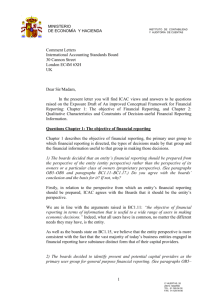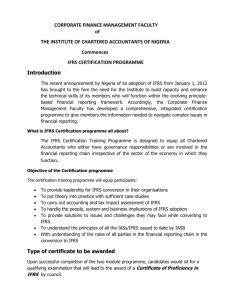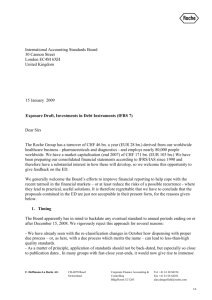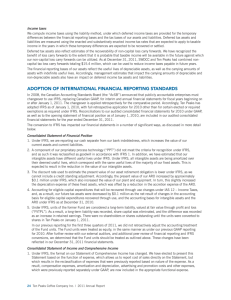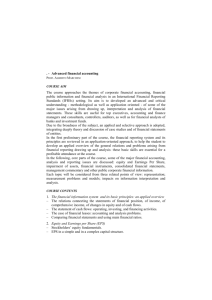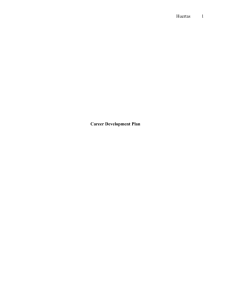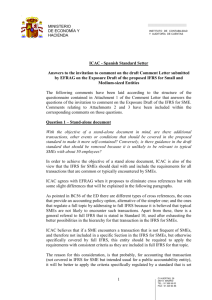Ref - International Accounting Standards Board
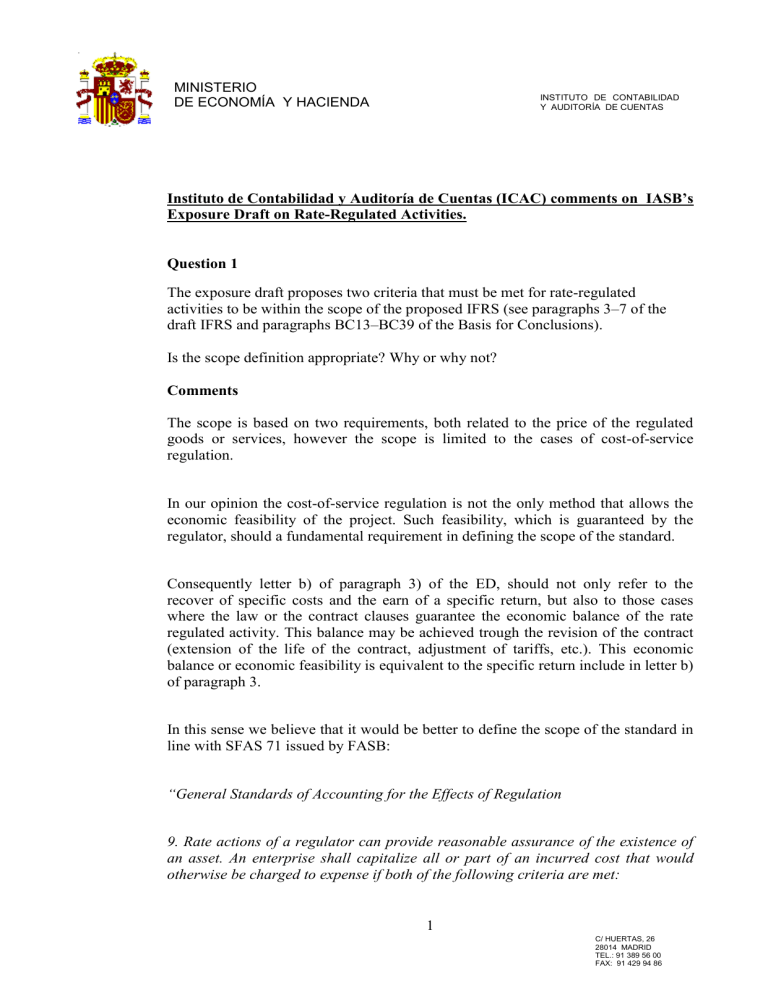
MINISTERIO
DE ECONOMÍA Y HACIENDA INSTITUTO DE CONTABILIDAD
Y AUDITORÍA DE CUENTAS a)
Secretaría de Estado de
Hacienda
Instituto de Contabilidad y Auditoría de Cuentas (ICAC) comments on IASB’s
Exposure Draft on Rate-Regulated Activities.
Question 1
The exposure draft proposes two criteria that must be met for rate-regulated activities to be within the scope of the proposed IFRS (see paragraphs 3–7 of the draft IFRS and paragraphs BC13–BC39 of the Basis for Conclusions).
Is the scope definition appropriate? Why or why not?
Comments
The scope is based on two requirements, both related to the price of the regulated goods or services, however the scope is limited to the cases of cost-of-service regulation.
In our opinion the cost-of-service regulation is not the only method that allows the economic feasibility of the project. Such feasibility, which is guaranteed by the regulator, should a fundamental requirement in defining the scope of the standard.
Consequently letter b) of paragraph 3) of the ED, should not only refer to the recover of specific costs and the earn of a specific return, but also to those cases where the law or the contract clauses guarantee the economic balance of the rate regulated activity. This balance may be achieved trough the revision of the contract
(extension of the life of the contract, adjustment of tariffs, etc.). This economic balance or economic feasibility is equivalent to the specific return include in letter b) of paragraph 3.
In this sense we believe that it would be better to define the scope of the standard in line with SFAS 71 issued by FASB:
“General Standards of Accounting for the Effects of Regulation
9. Rate actions of a regulator can provide reasonable assurance of the existence of an asset. An enterprise shall capitalize all or part of an incurred cost that would otherwise be charged to expense if both of the following criteria are met:
1
C/ HUERTAS, 26
28014 MADRID
TEL.: 91 389 56 00
FAX: 91 429 94 86
MINISTERIO
DE ECONOMÍA Y HACIENDA INSTITUTO DE CONTABILIDAD
Y AUDITORÍA DE CUENTAS a)
Secretaría de Estado de
Hacienda a. It is probable that future revenue in an amount at least equal to the capitalized cost will result from inclusion of that cost in allowable costs for ratemaking purposes. b. Based on available evidence, the future revenue will be provided to permit recovery of the previously incurred cost rather than to provide for expected levels of similar future costs. If the revenue will be provided through an automatic rate adjustment clause, this criterion requires that the regulator’s intent clearly be to permit recovery of the previously incurred cost.
If at any time the incurred cost no longer meets the above criteria, that cost shall be charged to earnings.”
Related to the above, the scope should include setter a) of paragraph 5 of IFRIC 12:
“ (a) the grantor controls or regulates what services the operator must provide with the infrastructure, to whom it must provide them, and at what price;”
A it is stated in BC37:
“IFRIC 12 requires an entity to recognise an asset for a right to charge customers for use of a public service at a price controlled or regulated by the grantor even though the entity bears the demand risk. The Board concluded that it would be inconsistent not to recognise regulatory assets when an entity has a similar right as a result of regulation rather than a contract.”
Consequently, the reason of the existence of a regulatory asset is not the method of calculating the tariffs, but in the case of activities subject to IFRIC 12, the fact that the grantor controls the services provide, and the guarantee of the economic feasibility of the regulated activity.
In this respect we include a publication of the International Monetary Fund, that shows how the effects of the renegotiating 2485 contracts in Latin America between
2
C/ HUERTAS, 26
28014 MADRID
TEL.: 91 389 56 00
FAX: 91 429 94 86
MINISTERIO
DE ECONOMÍA Y HACIENDA INSTITUTO DE CONTABILIDAD
Y AUDITORÍA DE CUENTAS a)
Secretaría de Estado de
Hacienda
: 1
All Sectors
Electricity
Transport
Renegotiated Concession
54%
21 %
69%
Water 81%
The mechanism of establishing tariffs was the following:
Price Caps
Rate of Return
56%
20%
Hybrid* 24%
*Hybrid regimes are defined when, under a price cap regulatory regime, a large number of costs components are allowed automatic pass through into tariff adjustments
Common Outcomes of the Renegotiation Process Percentage of renegotiated concession contracts with that outcome:
Delays on Investment Obligations Targets
Acceleration of Investment Obligations
69%
18%
Tariff Increases
Tariff Decreases
62%
19%
Increase in the number of cost components with automatic pass-through to tariff increases
Extension of Concession Period
Reduction of Investment Obligations
Adjustment of canon-annual fee paid by operator to government
Favorable to operator
Unfavorable to operator
Changes in the Asset-Capital Base
Favorable to Operator
Unfavorable to Operator
59%
38%
62%
31%
17%
46%
22%
1 Negotiating and renegotiating infrastructure ppps and concessions: key issues for policy makers J. Luis Guasch The World Bank and University of California, San Diego. http://www.imf.org/external/np/seminars/eng/2007/ppp/pdf/jlg.pdf
3
C/ HUERTAS, 26
28014 MADRID
TEL.: 91 389 56 00
FAX: 91 429 94 86
MINISTERIO
DE ECONOMÍA Y HACIENDA INSTITUTO DE CONTABILIDAD
Y AUDITORÍA DE CUENTAS a)
Secretaría de Estado de
Hacienda
This shows that there are other ways of adjustment apart from the cost-of-service regulation, that may be included in the contracts and that allow the economic balance of the rate regulated activities.
Finally from the text of the ED and in particular from paragraph 10, we do not appreciate the need of paragraph 7 in the ED.
Question 2
The exposure draft proposes no additional recognition criteria. Once an activity is within the scope of the proposed IFRS, regulatory assets and regulatory liabilities should be recognised in the entity’s financial statements (see paragraphs BC40–
BC42 of the Basis for Conclusions).
Is this approach appropriate? Why or why not?
We believe the approach is correct, as the probability of obtaining benefits and the reliability on measurement, as necessary requirements for the recognition of an asset, can be deducted from paragraph 2 of the ED.
Question 3
The exposure draft proposes that an entity should measure regulatory assets and regulatory liabilities on initial recognition and subsequently at their expected present value, which is the estimated probability-weighted average of the present value of the expected cash flows (see paragraphs 12–16 of the draft IFRS and paragraphs
BC44–BC46 of the Basis for Conclusions).
Is this measurement approach appropriate? Why or why not?
Comments
In order to achieve reliability in the measurement of assets, we propose the following measurement mechanism:
“Data for the total expected prices and expenses for each year of the concession must be obtained from the entinty Business Plan (BP). a. Expenses must be taken to profit and loss for each year in proportion to revenues for the year as a percentage of total expected revenues applied to the total expected expenses. If actual revenues for the year are higher than forecast, the expenses recognized must be in proportion to such actual revenues.
4
C/ HUERTAS, 26
28014 MADRID
TEL.: 91 389 56 00
FAX: 91 429 94 86
MINISTERIO
DE ECONOMÍA Y HACIENDA a)
Secretaría de Estado de
INSTITUTO DE CONTABILIDAD
Y AUDITORÍA DE CUENTAS
Hacienda using the method described in point a) above is capitalized as a regulatory asset.
These amounts are expensed where the difference between forecast and actual expenses is negative, following the criteria explained. In this regard, it should be taken into consideration that revenue streams generally increase over the term of the rate regulated activity. c. If the amount of the expenses incurred during any given year differs from the amount forecast in the Business Plan, the difference is treated as an increase nor reduction in the expenses taken to profit and loss for the year. d. If the Business Plan is modified in accordance with the specific legislation governing the rate regulated activity, and the changes made relate to extraordinary events that significantly alter the circumstances originally considered in the BP, their effects will not cause any adjustment of expenses already recognized through the profit and loss account in priory years. The treatment of such effects will be based on the conditions described in the above paragraphs for the remaining period after approval of the modified BP.”
Question 4
The exposure draft proposes that an entity should include in the cost of selfconstructed property, plant and equipment or internally generated intangible assets used in regulated activities all the amounts included by the regulator even if those amounts would not be included in the assets’ cost in accordance with other IFRSs (see paragraph 16 of the draft IFRS and paragraphs BC49–BC52 of the
Basis for Conclusions). The Board concluded that this exception to the requirements of the proposed IFRS was justified on cost-benefit grounds.
Is this exception justified? Why or why not?
Comments
We do not support the exception included in paragraph 16, which would not permit comparability and transparency of financial statements.
In this sense, we believe that those amounts that should not be capitalised according to other IFRS, would be capitalised as regulatory assets, based on the terms of the standard
Question 5
The exposure draft proposes that at each reporting date an entity should consider
5
C/ HUERTAS, 26
28014 MADRID
TEL.: 91 389 56 00
FAX: 91 429 94 86
MINISTERIO
DE ECONOMÍA Y HACIENDA a)
Secretaría de Estado de
INSTITUTO DE CONTABILIDAD
Y AUDITORÍA DE CUENTAS
Hacienda from the actions of each different regulator. If the entity concludes that it is not reasonable to assume that it will be able to collect sufficient revenues from its customers to recover its costs, it tests the cash-generating unit in which the regulatory assets and regulatory liabilities are included for impairment in accordance with IAS 36 Impairment of Assets . Any impairment determined in accordance with IAS 36 is recognised and allocated to the assets of the cash-generating unit in accordance with that standard (see paragraphs 17–20 of the draft IFRS and paragraphs BC53 and BC54 of the Basis for Conclusions).
Is this approach to recoverability appropriate? Why or why not?
Comments
We agree with the impairment approach proposed. The regulation of the regulatory asset impairment reflects the demand risk of the rate regulated activity, which supports the need of including in the scope of the ED, the activities subject to IFRIC
12.
Quesion 6
The exposure draft proposes disclosure requirements to enable users of financial statements to understand the nature and the financial effects of rate regulation on the entity’s activities and to identify and explain the amounts of regulatory assets and regulatory liabilities recognised in the financial statements
(see paragraphs 24–30 of the draft IFRS and paragraphs BC59 and BC60 of the
Basisfor Conclusions).
Do the proposed disclosure requirements provide decision-useful information?
Why or why not? Please identify any disclosure requirements that you think should be removed from, or added to, the draft IFRS.
Comments
We agree with the disclosure requirements.
Question 7
First time adoption
The exposure draft proposes that an entity should apply its requirements to regulatory assets and regulatory liabilities existing at the beginning of the earliest comparative period presented in the period in which it is adopted
6
C/ HUERTAS, 26
28014 MADRID
TEL.: 91 389 56 00
FAX: 91 429 94 86
MINISTERIO
DE ECONOMÍA Y HACIENDA a)
Secretaría de Estado de
INSTITUTO DE CONTABILIDAD
Y AUDITORÍA DE CUENTAS
Hacienda
Conclusions). Any adjustments arising from the application of the draft IFRS are recognised in the opening balance of retained earnings.
Is this approach appropriate? Why or why not?
Comments
We agree with the approach proposed.
Pregunta 8
Do you have any other comments on the proposals in the exposure draft?
We have a final comment related with the interaction of the present ED and IFRIC
12. In this sense we have some doubts of whether the contractual obligations included in paragraph 21 and example 2 of IFRIC 12, would be modified by the future IFRS on Rate regulated activities.
We found it necessary to modify paragraph C7 of the ED, in order to clarify whether the activities that are within the scope of IFRIC 12, are at the same time subject to the future IFRS on Rate regulated activities.
As we have stated in our comments on question 1, we believe that an entity that is subject to IFRIC 12, is necessarily under the scope of the ED. The existence of a mechanism that permits adjustments during the life of the contract in order to guarantee the initial terms of the contract, is established in several laws i.e Spanish legislation.
Madrid, 19 de november de 2009
7
C/ HUERTAS, 26
28014 MADRID
TEL.: 91 389 56 00
FAX: 91 429 94 86
